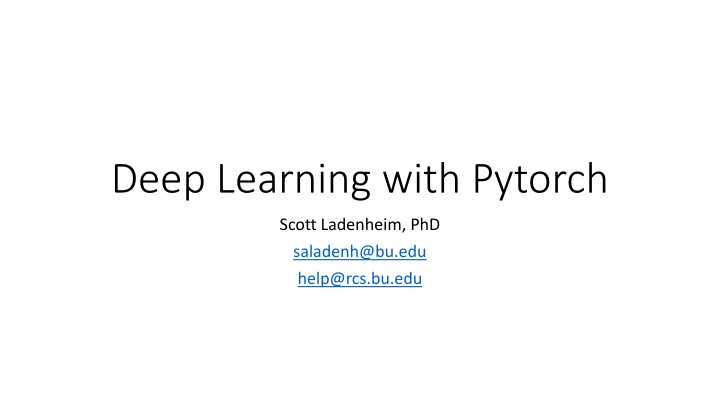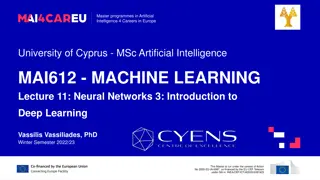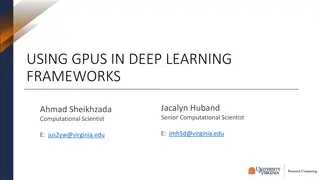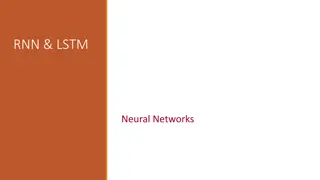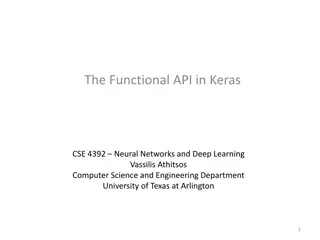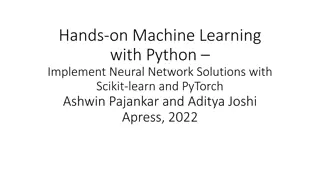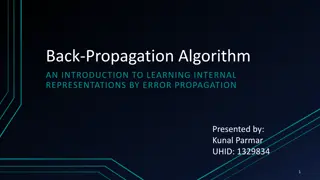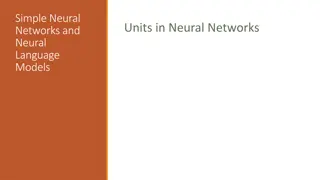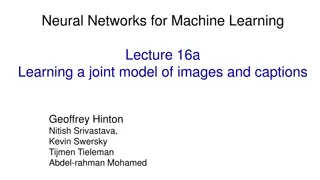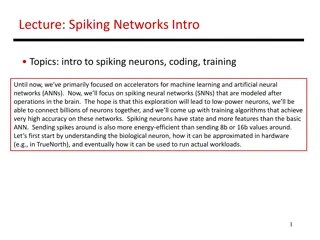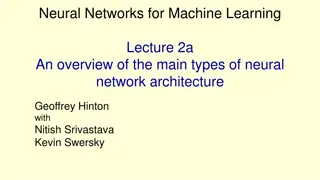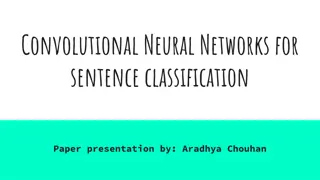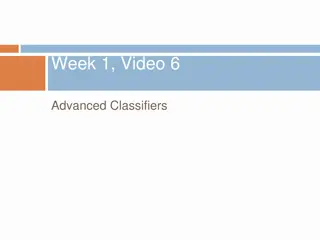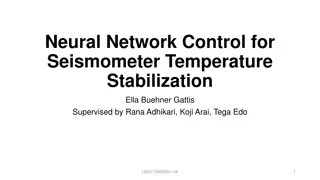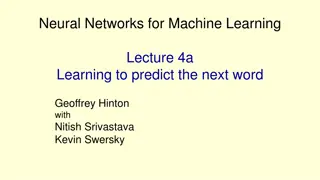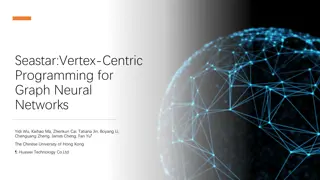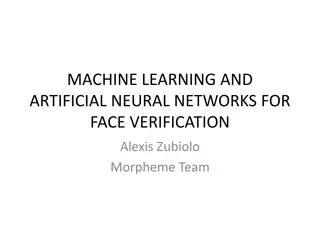Deep Learning with Pytorch: Neural Networks and Implementation
This comprehensive guide covers neural networks, deep learning concepts, Pytorch implementation for binary and multiclass classification, GPU utilization, activation functions, loss functions, forward propagation, tensor operations, and more. Dive into the world of artificial intelligence, machine learning, and deep learning as you explore concepts and applications in this informative resource.
Download Presentation

Please find below an Image/Link to download the presentation.
The content on the website is provided AS IS for your information and personal use only. It may not be sold, licensed, or shared on other websites without obtaining consent from the author.If you encounter any issues during the download, it is possible that the publisher has removed the file from their server.
You are allowed to download the files provided on this website for personal or commercial use, subject to the condition that they are used lawfully. All files are the property of their respective owners.
The content on the website is provided AS IS for your information and personal use only. It may not be sold, licensed, or shared on other websites without obtaining consent from the author.
E N D
Presentation Transcript
Deep Learning with Pytorch Scott Ladenheim, PhD saladenh@bu.edu help@rcs.bu.edu
Outline Neural networks and deep learning Neural networks for binary classification Part 1 Pytorch implementation Multiclass classification Part 2 Using GPUs
Artificial intelligence: simulation of human intelligence by machines Machine learning: computers learning to perform tasks based on data Deep learning: a machine learning technique that mimics networks of neurons Artificial intelligence Machine learning Deep learning
Neuron ?1 z = ?1?1+ ?2?2+ ? ? = ?(?) ? = ? ( ?,?) ?2 Linear Activation function Loss function Output Inputs combination of inputs
Logistic Regression 1 Activation function is the sigmoid function ? ? = The loss function has the form ?,?(?)= ?(?)log ? + 1 ?(?)log(1 ?) We find weights that minimize the loss function using an optimization routine 1+ ? ?
Neural Network ?1 [1] [2] ?1 ?1 ?2 ( ?,?) ? [1] [2] ?2 ?2 ?3 [1] [2] ?3 ?3 ?4 Loss function Output layer Input layer Hidden layers
Forward propagation The process of transforming input data to output data in the neural network Forward propagation uses matrix- vector (tensor) operations Activation functions are applied to each node A loss function is calculated at the end Forward propagation can be implemented efficiently with vectorization ?1 [1] [2] ?1 ?1 ?2 ( ?,?) ? [1] [2] ?2 ?2 ?3 [1] [2] ?3 ?3 ?4 Loss function Hidden layers Output layer Input layer
Forward propagation Tensor operations The input to each layer is a vector ?? (?0= ?) Weights for each layer ?[?] form a matrix ?1 ?2 ?3 ?[1] = ?(?) = ?(?0? + ?[0]) Repeat this for every layer ?1 [1] [2] ?1 ?1 ?2 ( ?,?) ? [1] [2] ?2 ?2 ?3 ?[0]= 3 4 [1] [2] ?3 ?3 ?4 Output layer Loss function Hidden layers Input layer
Activation functions Nonlinear Differentiable See the documentation for others Sigmoid ReLU Tanh
Output layer: Loss and Cost function Binary classification uses sigmoid ? = ? ? = ?(?2?2+ ?[2]) Loss ?,?(?)= (??log ? + 1 ??log 1 ? ) Cost function ? ? =1 ? ?=1 ?1 [1] [2] ?1 ?1 ?2 ( ?,?) ? [1] [2] ? ?2 ?2 ??,?? ?3 [1] [2] ?3 ?3 ?4 Output layer Loss function Hidden layers Input layer
Backward propagation The process of updating the weights to minimize the cost function Compute ?(?) Update ? ? ? ?(?) There are autograd functionalities built into Pytorch to compute this efficiently After training the model can be applied to unseen input data ?1 [1] [2] ?1 ?1 ?2 ( ?,?) ? [1] [2] ?2 ?2 ?3 [1] [2] ?3 ?3 ?4 Output layer Loss function Hidden layers Input layer
Manual backward propagation Given ? = ?1,?2 and ? determine coefficients ?1,?2,? that minimize the loss function Need to compute how much a small change in ?1,?2,? affects the loss Compute partial derivatives ??1,??2,?? ? ? ?= 2( ? ?) ?1 ? ? = ?,? = ? ?2 ? = ?1?1+ ?2?2+ ? ? ??1 ? ? ? ? ? ??1 ?2 ??1= = = 2 ? ? ?1 ? ??2 ? ? ? ? ? ??2 ??2= = = 2 ? ? ?2 ? ?? ? ? ? ? ? ??= 2 ? ? ?? = =
Terminology review Suppose we have 2000 training examples. Split the training set into batches of 400 5 batches 5 iterations to complete 1 epoch Learning rate the factor ? in the update rule Epoch 1 forward and backward propagation over the training set Batch subset of the training set Iterations number of batches needed to complete 1 epoch
Optimized tensor library for deep learning using GPUs and CPUs Python based library but users can program in C/C++ Primary goal is usability Secondary goal is performance Created by Facebook AI Research Lab Released in 2016 Open source
Using Pytorch Tensors Dataset class Dataloader class nn.Module Class Architecture input, hidden, output layers Forward propagation Backward propagation Loss functions Optimizers
Tensors Pytorch torch.tensor() torch.tensor(np.array([[1, 2, 3], Can add, subtract, and, multiply Defined operations for multiplying tensors with valid dimensions Autograd capabilities make it easy to track gradients of tensors https://pytorch.org/docs/stable/tensors.html#tenso r-class-reference Multi-dimensional arrays of data [4, 5, 6]])) 1-D tensor is a vector ? = [?1,?2, ,??] ?11 ??1 ?1? ??? ? = 2-D tensor is a matrix 3-D tensor N-D tensor
DataSet and DataLoader For complex data, you need to create DataSet and DataLoader. DataSet is data class, loads data one at a time. DataLoader is the bridge between DataSet and the Optimizer.
DataSet Class The Dataset retrieves our dataset s features and labels one sample at a time. must implement three functions: __init__, __len__, and __getitem__. The __init__ function is run once when instantiating the Dataset object. The __len__function returns the number of samples in our dataset. The __getitem__function loads and returns a sample from the dataset at the given index idx. class dataname(Dataset): def __init__(self, xxx, transform=None, target_transform=None): def __len__(self): return xxxx_len # returns the length def __getitem__(self, idx): return xxxx, yyyy # gets the data https://pytorch.org/tutorials/beginner/basics/data_tutorial.html
DataLoader Class DataLoader is an iterable that abstracts the complex data passing process and makes our lives easier. pass samples in minibatches , reshuffle the data at every epoch to reduce model overfitting use Python s multiprocessing to speed up data retrieval. from torch.utils.data import DataLoader train_dataloader = DataLoader(training_data, test_dataloader = DataLoader(test_data, batch_size=64, shuffle=True) batch_size=64, shuffle=True)
How to define a nn.Module subclass torch.nn.Module class is how we implement the neural network Have to implement 2 methods __init__(self) - where neural network layers and member data of the class are initialized forward(self, x) method that defines the operations of the forward propagation, e.g., how data at each layer is manipulated +Easy to customize the neural network +Have access to all the layers that you define +Easy to view and manipulate the parameters within the layers
Loss functions Choice of loss function depends on Activation function used in the output layer Task you want your model to do (e.g., regression, binary/multiclass classification) Full list https://pytorch.org/docs/stable/ nn.html#loss-functions Regression Mean squared error nn.MSELoss Binary classification Binary cross-entropy nn.BCELoss
Optimizers torch.Optim Package that implements various optimization algorithms Allows you to adjust the learning rate with lr_scheduler All optimizers are listed here https://pytorch.org/docs/stable/ optim.html Popular optimizers Adam Adamx RMSProp SGD Stochastic Gradient descent LBFGS
Pytorch in Practice Open the Jupyter notebook `PytorchNeuralNetworkClassifier.ipynb` in http://rcs.bu.edu/classes/MSSP/sp23/DeepLearning/
